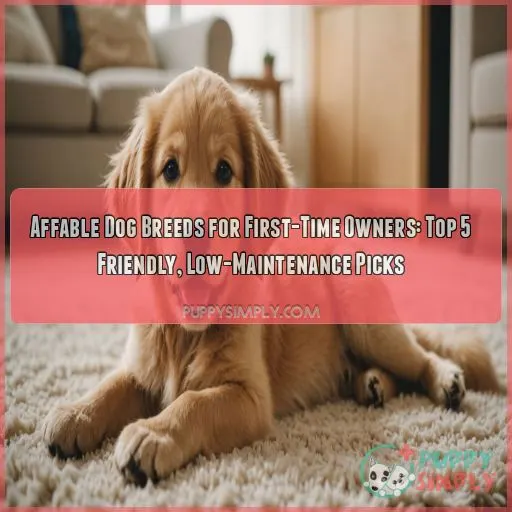This site is supported by our readers. We may earn a commission, at no cost to you, if you purchase through links.

Golden Retrievers and Labrador Retrievers are like the class clowns of the dog world – friendly, loyal, and always up for a good time.
If you’re more of a lap dog person, Cavalier King Charles Spaniels are cuddly charmers that’ll melt your heart.
For those who want a gentle giant, Bernese Mountain Dogs are big softies with even bigger hearts.
Ready to discover which furry friend will have you doing the happy dance?
Table Of Contents
- Key Takeaways
- Choosing the Right Breed
- Preparing for Your New Dog
- Factors to Consider When Choosing a Breed
- Overcoming Challenges as a First-Time Owner
- Welcoming Your Dog Home
- 9 Great Dog Breeds for First-Time Owners
- Breeds You Should Avoid
- Pet Insurance for Your New Dog
- Frequently Asked Questions (FAQs)
- Conclusion
Key Takeaways
- Golden Retrievers and Labrador Retrievers are the class clowns of the dog world – friendly, loyal, and always up for a good time. They’re perfect for first-time owners looking for an affable, easy-to-train companion that’ll have you doing the happy dance!
- Choosing the right breed is like finding your puzzle piece in a world full of dogs. Consider your lifestyle, living space, and energy levels before bringing home your furry soulmate. After all, you don’t want to be dragged out of bed at 6 am for a brisk walk if you’re more of a night owl!
- Puppy-proofing your home is essential, unless you want your new best friend to turn your fancy shoes into chew toys. Get down on all fours to spot potential dangers at your dog’s eye level – it’s a great workout, and you’ll see the world from your pup’s perspective!
- Remember, a tired dog is a well-behaved dog. Whether you’re hitting the dog park or creating a backyard obstacle course, keeping your new pal physically and mentally stimulated is key. Who knows, you might even discover your inner dog whisperer in the process!
Choosing the Right Breed
Choosing the right dog breed is super important for first-time owners. You’ll want a pup that’s easygoing, adaptable, and a good fit for your lifestyle.
Research Different Breeds
When choosing your first furry friend, doing your research is key. You’ll want to learn about different breeds’ needs, temperaments, and whether they’ll fit with your lifestyle. It’s like dating—you’re looking for that special someone who clicks with you and your daily routine.
Consider factors like breed temperament, history, lifespan, health, and grooming requirements. These details will give you a glimpse into what life will be like with your new pup and help you make an informed decision.
Golden Retriever
Golden retrievers are a fantastic choice for first-time dog owners, and here’s why:
- Temperament: Known for their friendly, loyal nature, golden retrievers are good with children and adaptable to various living situations. They’re patient and loving, making them ideal furry companions.
- Training: These pups are highly trainable, which is a plus for novice owners. They respond well to positive reinforcement and consistent schedules.
- Grooming: Golden retrievers have beautiful coats that require regular brushing and maintenance. It’s a great way to bond with your pup and keep their fur healthy.
- Health and Activities: As active dogs, they’ll need daily walks and playtime. Golden retrievers are generally healthy, but like all breeds, regular check-ups and a good relationship with your vet are key to their well-being.
Labrador Retriever
If you’re a first-time dog owner, a Labrador Retriever could be your new best friend.
Known for their loyalty and affection, Labs are great with kids and extremely trainable.
They’re friendly with strangers and thrive in active households, so get ready to hit the dog park!
With moderate grooming needs and a playful nature, Labs will keep you on your toes but will reward you with years of devoted companionship.
Cavalier King Charles Spaniel
If you’re a first-time dog owner, the Cavalier King Charles Spaniel is a great choice. Known for their sweet, gentle nature, these pups are highly adaptable and affectionate, making them ideal companion pets. Here are some key things to keep in mind:
- Temperament: Cavaliers are friendly and affectionate, always up for a cuddle or playtime. They get along well with people of all ages and can adapt to different living situations.
- Trainability: They’re highly trainable, which makes teaching them new tricks a breeze and helps with their overall behavior.
- Grooming: Their coats require regular grooming to keep them looking their best.
- Exercise: Cavaliers need a moderate amount of exercise, so daily walks and playtime will do the trick.
With their sweet disposition and trainability, Cavaliers are a top pick for first-time owners.
Bernese Mountain Dog
Berners are affectionate, gentle giants with a striking appearance. Their temperament is calm, patient, and loving, making them excellent family pets. They’re highly intelligent, easy to train, and keen to please, but they can be a little stubborn during adolescence.
Bernese Mountain Dogs are active and require daily exercise. They’re social and enjoy human company, but they can be left alone for up to eight hours with proper crate training. They’re good with children but may need supervision due to their large size. They’re also good with other dogs and pets if properly introduced.
Berners have thick, double coats that require regular grooming and moderate exercise to prevent matting and overheating. Their large size means they’re not suited for apartments and require a home with a large, fenced yard.
Health issues to watch for include hip and elbow dysplasia, arthritis, progressive retinal atrophy, cancer, and von Willebrand’s disease. Their lifespan is shorter than other breeds, typically 6-10 years.
Bichon Frise
The Bichon Frise is a cheerful and friendly dog breed that’s perfect for first-time owners. They’re small, require minimal exercise, and are well-suited for families. With their easy-going temperament, they make a great addition to any household.
As a first-time owner, you’ll appreciate their low-maintenance grooming needs. Their fluffy coats are adorable, but they don’t require extensive care. A Bichon Frise is an excellent choice if you’re short on space or energy for long walks. They’re content with a cozy bed and some indoor playtime.
You’ll find training a breeze with this intelligent breed. They’re quick to learn and enthusiastic to please, making it easy for you to navigate the challenges of puppyhood.
Preparing for Your New Dog
So you’ve picked your pup? Now it’s time to get ready for their arrival. There’s a lot to think about before your fluffy friend bounds through that door, so let’s get cracking.
From finding a vet to preparing your home, we’ll cover all the bases to make sure things go smoothly for both you and your new furry family member.
Find a Veterinarian
As a first-time dog owner, finding a veterinarian is really important for your pup’s health and well-being. You’ll want to find a vet you trust and feel comfortable with, as they’ll be an essential partner in your dog’s care. Here’s what to think about:
- Vet Recommendations: Ask friends, family, or other pet owners in your area for recommendations. Personal referrals can give you insight into vets that others have had good experiences with.
- Emergency Care: Identify a 24/7 emergency veterinary clinic or animal hospital near you. Emergencies can happen, and you’ll want to know where to go for urgent care.
- Appointment Scheduling: Find out the regular hours and availability of your chosen vet. Some vets may offer extended hours or flexible scheduling to accommodate your needs.
- Cost Comparison: Vet costs can vary, so it’s worth comparing prices for routine check-ups, vaccinations, and potential emergency care. Don’t forget to ask about payment options and insurance coverage.
- Vet Services: Different vets may offer different services. Make sure your chosen vet provides a range of services, including diagnostics, treatments, and preventive care.
Understand Responsibilities
Owning a dog is a big responsibility.
It’s not all fun walks in the park and cuddles on the couch.
It’s important to be aware of the time, effort, and resources needed to care for your furry friend.
This includes everything from providing love and attention to dealing with the not-so-glamorous aspects of dog ownership, like picking up poop and dealing with the occasional accident in the house.
It’s a serious commitment, so make sure you’re ready to roll up your sleeves and take on the joys and challenges that come with being a dog parent.
Prepare Your Home
Before bringing your new dog home, it’s important to get your place ready to make sure they’re safe and comfy. Here’s what you need to do:
- Dog-proof your space: Just like child-proofing, dog-proofing your home is essential. Remove any potential hazards at your dog’s eye level, such as toxic plants, fragile decor, or loose cables.
- Create safe zones: Set up a cozy sleeping area, preferably in a quiet corner of your home. Make sure it’s away from high-traffic areas to give your dog a sense of peace and security.
- Provide pet supplies: Stock up on food bowls, a water dispenser, toys, and other essentials. Having these ready will help your dog adjust to their new home and settle in faster.
Provide Proper Food and Nutrition
Feeding your dog the right food is super important. You need to think about things like their age, size, breed, and any health issues they might’ve when picking a brand. A healthy diet helps keep your furry friend happy and healthy. Ask your vet for some suggestions or look into high-quality options that are made for specific breeds or needs.
Factors to Consider When Choosing a Breed
Choosing the right dog breed is like finding your puzzle piece in a world full of dogs. There’s a lot to think about when making your pick, and we’re here to help you figure out what matters most.
Lifestyle
When choosing your first furry friend, it’s really important to think about your lifestyle. Do you live in an apartment or have a backyard? Are you an active person who loves the outdoors, or do you prefer quiet evenings at home? Maybe you travel frequently or have a busy work schedule. Think about your daily routine and be honest about how much time and energy you can devote to your new companion.
Some dogs need more space to roam and run, while others are happy with small spaces and frequent walks. If you’re always on the go, opt for a low-maintenance breed that doesn’t need constant attention. Conversely, if you’re an outdoor enthusiast, choose a breed that matches your activity level and enjoys adventures.
Dog Size
When choosing your first furry friend, size matters. Go too big, and you might struggle to manage them, especially if you’re living in a cozy apartment. Opt for a tiny pup, and you may find yourself tripping over them in tight spaces.
Consider your living space and whether you can provide enough room for a large dog to roam and relax. If you’re short on square footage, small breeds like the Papillon or Yorkshire Terrier might be a better fit. These little ones are adaptable and won’t mind apartment living.
On the other hand, if you’ve got ample space for a four-legged friend to stretch their legs, a larger breed could be a perfect match. Just remember that bigger dogs often come with bigger exercise needs, so be sure you can keep up with their energetic side.
Activity Level
When choosing your first furry friend, it’s important to think about your energy levels and how they match up with those of your prospective pup. After all, you don’t want to be dragging yourself out of bed at 6 am for a brisk walk if you’re more of a night owl!
- High-energy breeds: If you’re an active soul who loves nothing more than exploring the great outdoors, opt for high-energy breeds like the Soft Coated Wheaten Terrier or the Labrador Retriever. These pups will happily join you on hikes and runs, keeping pace with your adventurous spirit.
- Low-energy breeds: On the flip side, if your idea of a perfect evening involves curling up with a good book and a cup of tea, think about low-energy breeds such as the Shih Tzu or the Whippet. These dogs are content with shorter walks and will happily snuggle up with you on the couch.
- Exercise needs: Remember, every dog, regardless of breed, requires some form of exercise. Even low-energy breeds need daily walks and playtime to stay healthy, both physically and mentally. Dog parks, where they can run off-leash, are a great way to make sure they get their zoomies out!
Maintenance
Grooming is an essential part of dog care. It keeps your pup healthy, happy, and looking sharp. Here’s what you need to know about coat care, nail trimming, bathing, and dental hygiene.
- Coat Care: Brushing your dog’s coat regularly prevents mats and tangles. Use the right brush for their coat type. Long-haired dogs need daily brushing, medium-haired dogs should be brushed weekly, and short-haired dogs only need brushing every few weeks.
- Nail Trimming: Keeping your dog’s nails short is important for their comfort and gait. Use a nail clipper or grinder designed for their size and nail type. Guillotine-style clippers are ideal for small to medium dogs, while scissor-style clippers suit larger breeds. Be careful not to cut into the ‘quick,’ the sensitive area inside the nail that can bleed.
- Bathing: How often you bathe your dog depends on their breed, coat type, and activity level. Use a gentle, dog-specific shampoo, and avoid their eyes, ears, and nose. Lukewarm water is best.
- Dental Hygiene: Brush your dog’s teeth daily, or a few times a week, with pet-safe toothpaste and a pet toothbrush. Start by rubbing their teeth and gums with your finger, then gradually introduce the toothbrush.
Purebred Vs. Mixed Breed
- Purebred dogs offer more predictability when it comes to temperament, health, and appearance. You can reasonably expect certain traits and behaviors, making it easier to prepare and manage their specific needs.
- Mixed breeds, often called mutts, offer the advantage of genetic diversity, which can reduce the risk of certain health issues. They come in various sizes and temperaments, so you’re likely to find one that fits your lifestyle and space constraints.
- Cost is another factor. Purebred dogs can be more expensive, especially if they come from a reputable breeder. Mixed breeds are often more affordable and may already have basic training, which is a plus for first-time owners.
Overcoming Challenges as a First-Time Owner
First-time dog ownership comes with challenges, from training struggles to puppy teething. We’ll help you tackle these hurdles so you can focus on the fun parts of having a furry best friend.
Training Struggles
Training your first dog can feel overwhelming, but with positive reinforcement, consistency, and patience, you’ll be on the right track. Focus on creating a consistent schedule for training and stick to it. If you’re unsure where to start, consider signing up for obedience classes. It’s a great way to learn the basics and get professional help.
Puppy Teething and Chewing
Puppy-proofing your home is essential when welcoming a new furry friend. Here’s what you need to know about puppy teething and chewing:
- Safe Chews: Offer your puppy a variety of safe chew toys, like rubber or nylon bones, to satisfy their chewing needs. Avoid giving them old shoes or socks as chew toys, as they can’t differentiate between old and new ones.
- Chew Toy Choices: Choose toys that are the right size for your puppy’s mouth and watch them play to make sure they don’t chew off and swallow small pieces. Provide a mix of textures to keep things interesting.
- Destructive Chewing: If your puppy starts chewing on furniture or other inappropriate items, redirect their attention to an approved chew toy and reward them for making the right choice.
Separation Anxiety
| Coping Strategies | Crate Training | |
|---|---|---|
| 1 | Gradually accustom your dog to being alone. Start with short periods and gradually increase the duration. | Provide a comfortable crate or enclosed space for your dog to feel secure. |
| 2 | Leave them with interactive toys and treats to keep them entertained and relieve boredom. | Create a positive association with the crate by offering treats and praise. |
| 3 | Establish a consistent routine with regular exercise and playtime before you leave. | Use the crate consistently for short periods when you’re home to build familiarity. |
| 4 | Consider hiring a dog walker or asking a friend to check in on your pup during long absences. | Make sure the crate is well-ventilated and has enough space for your dog to stand, turn around, and lie down comfortably. |
Healthcare Responsibilities
Being a dog owner means taking on the role of their primary caregiver, so it’s important to be prepared for any health-related challenges that may arise. Here’s what you need to know:
- Establish a Health Schedule: Create a calendar or set reminders for vaccinations, check-ups, and any ongoing treatments. Regular vet visits are key for early detection of potential issues.
- Build a Relationship with a Veterinarian: Find a trusted vet who can guide you through preventative care, emergency situations, and general health advice. It’s comforting to have a reliable expert on speed dial.
- Explore Pet Insurance: Vet costs can add up, so consider investing in pet insurance to ease financial stress. Basic policies cover accidents and illnesses, and you can often add preventative care and other benefits.
- Set Aside Emergency Funds: Unexpected illnesses or injuries happen, so it’s wise to have a dedicated fund for vet bills. Even with insurance, there may be out-of-pocket expenses, so plan ahead to make sure your furry friend gets the best care.
Grooming Needs
Grooming is an essential part of dog care, and different breeds have varying needs. Here’s a concise guide to help you navigate the grooming requirements of your new furry friend:
- Grooming Tools: Equip yourself with the right tools. Brushes, combs, and clippers are essential for maintaining your dog’s coat. Ask your veterinarian or a professional groomer for recommendations specific to your dog’s breed.
- Brushing Frequency: Establish a regular brushing routine. Depending on your dog’s coat type, daily or weekly brushing may be necessary to prevent matting and promote a healthy coat.
- Bathing Tips: Bathing is an important part of grooming, but it shouldn’t be overdone. Aim for occasional baths, using dog-specific shampoo, and make it a positive experience with treats and praise.
- Professional Grooming: For more complex grooming tasks, consider taking your dog to a professional groomer. They’ve the expertise to handle nail trimming, ear cleaning, and intricate haircuts.
Welcoming Your Dog Home
You’ve done your research, picked your pup, and now it’s time to bring them home. This section will guide you through creating a safe and welcoming environment for your new furry friend.
Check for Safety Hazards
Before bringing your furry friend home, perform a safety audit. Get down on all fours to spot potential dangers at your dog’s eye level. Stow away household items like toxic plants, medications, and cleaning supplies. Conceal electrical cords, and secure fragile valuables. Dog-proof your home to keep your pup safe and sound.
Acquaint Them With the Grooming Process
It’s bath time! Get your pup acquainted with grooming early on. First, gather your grooming tools: shampoo, brush, nail clippers, and maybe a cute bow or bandana for after.
Introduce your dog to the process gradually. Start with a puppy bath, followed by their first trim, and then ease into a deshedding routine if needed. Make nail trimming a regular part of the routine, too. Before you know it, your pup will be a grooming pro!
Comfortable Bed and Food Station
Setting up a comfy space for your new furry friend is all about getting the basics right. Here’s what you need to know:
- Bed Placement: Choose a quiet spot for their bed, away from high-traffic areas. You want your pup to have a peaceful place to retreat and relax.
- Food Bowl Size: Go for a bowl that’s sized just right for their meals. Too big, and they might overeat. Too small, and they’ll be hanging onto the edges to get their fill.
- Water Bowl Type: Opt for a no-spill water bowl to keep their hydration station mess-free. You don’t want to deal with accidental spills and slippery floors.
- Feeding Schedule: Establish a routine feeding schedule. Dogs thrive on consistency, and it’ll help you monitor their eating habits and overall health.
Toilet Area
Potty training your new pup? Create a designated toilet area and consistently take them there. Whether it’s a specific spot in your yard or a pee pad indoors, consistency is key. Expect accidents, but don’t worry—it’s all part of the process. With patience and positive reinforcement, your furry friend will get the hang of it!
Provide Toys and Entertainment
Giving your new pup toys and things to do is super important.
It keeps their mind busy and helps stop them from chewing on things they shouldn’t.
Get a mix of interactive toys, dog puzzles, and chew toys to keep them entertained.
Remember to watch your dog while they’re playing to make sure they’re safe and don’t chew on anything they shouldn’t.
9 Great Dog Breeds for First-Time Owners
So, you’re thinking of getting your first dog? There’s a lot to think about before you take the plunge. First, you need to find a breed that’s a good fit for your lifestyle and experience.
Lucky for you, we’ve sniffed out nine of the best dog breeds for first-time owners. From gentle and affectionate companions to active and trainable pals, we’ve got you covered.
Gentle and Affectionate
If you’re looking for a furry friend to snuggle up with, there are plenty of dog breeds known for their gentle and affectionate nature. Here are a few that might just steal your heart:
- Cavalier King Charles Spaniel: These sweet pups are friendly, gentle, and adaptable. They love nothing more than cuddling up with their favourite humans.
- Boxer: While Boxers make great guard dogs, they’re also big softies who crave affection and are super patient with kids.
- English Springer Spaniel: Cheerful and affectionate, these dogs are always happy to please. They make loyal companions and are easily trained.
- Papillon: Small but mighty, Papillons are friendly and alert. They’re just as happy playing outdoors as they’re curled up on the couch with you.
- Shih Tzu: These little fluffballs are the epitome of lap dogs. They’re affectionate and easygoing, and their luxurious coats are perfect for snuggling into.
Trainability
Training your first dog can be a bit daunting, especially if you want a pup that’s easy to teach. You’ll want a breed that’s quick to learn and loves to please. Here are some top picks known for their trainability:
- Cavalier King Charles Spaniel: These gentle pups are highly trainable and adaptable, making them a great choice for first-time owners.
- Boxer: Boxers are patient and spirited with kids, and they’re also trainable.
- English Springer Spaniel: Cheerful and affectionate, these dogs are eager to please, which makes training a breeze.
- Papillon: Small but mighty, Papillons are alert and trainable.
- Poodle: Poodles are exceptionally smart and excel in dog sports, so they’ll be top students in training sessions.
- Shih Tzu: Don’t let their luxurious coats fool you—Shih Tzus are trainable and make great companion pets.
- Soft Coated Wheaten Terrier: This active breed is happy, steady, and alert, and they’re definitely trainable.
- Whippet: Whippets are naturally attached to people and are also trainable.
- Labrador Retriever: Extremely trainable and intensely loyal, Labs are a popular choice for a reason.
Exercise Needs
Exercise needs vary depending on your dog’s age, breed, and health. A young, energetic Golden Retriever may need more exercise than a calm, senior dog of the same breed.
Most dogs need around 30 to 60 minutes of daily physical activity. Active breeds should get at least 30 minutes of hard aerobic exercise most days. Remember, a tired dog is a well-behaved dog!
If you’re an outdoor enthusiast, consider a dog that can join you on hikes or runs. Breeds like Labrador Retrievers and Boxers thrive in active households.
For a more relaxed companion, the Cavalier King Charles Spaniel, Maltese, and Shih Tzu only need moderate daily exercise.
Toy breeds like Pugs and Chihuahuas may seem content with indoor play, but they still need daily walks to stay healthy.
Don’t forget, exercise isn’t just physical—it’s mental too. Dogs need social interaction and mental stimulation to stay sharp. Puzzle toys and training exercises are a great way to keep their minds active.
Breeds You Should Avoid
While there are many paw-some breeds out there, some aren’t the best fit for first-time owners. You’ll want to steer clear of certain breeds that might be more challenging to handle.
Let’s take a closer look at the breeds that are better left to more experienced owners.
Shiba Inu
The Shiba Inu is a spirited and good-natured breed, known for their distinctive fox-like appearance. They’re highly intelligent, active, and energetic, with a strong prey drive and a bold, stubborn streak. Because of this, they require lots of exercise and mental stimulation to prevent boredom and destructive behaviours.
Shiba Inus need at least an hour of exercise every day, including a daily walk of around 45 minutes to an hour. This can be split into two walks if your schedule allows, but be sure to stick to a routine as they thrive on predictability. During walks, provide opportunities for your Shiba to explore and sniff, as this provides valuable mental stimulation.
Shiba Inus also need purposeful activity and mental stimulation. Here are some ideas for exercising your Shiba:
- Play fetch with balls, frisbees, or sticks.
- Play tug-of-war with a tug rope.
- Set up an agility or obstacle course in your backyard, or use stairs for a good workout.
- Create a digging pit or sand box for them to dig in.
- Play hide-and-seek with treats.
- Take them on hikes or swims.
- Practice obedience training.
Border Collie
Border Collies are highly intelligent, energetic, and hardworking dogs.
They excel in canine sports like obedience, flyball, agility, and tracking.
Their smarts make them easy to train, but their high energy means they’re not ideal for first-time owners.
Border Collies need lots of physical and mental exercise to avoid problem behaviors.
Without it, they can become hyperactive and destructive.
They’re natural herders, so they may chase and nip at kids and other pets.
Socialization and training are key to channeling their instincts.
Beagle
Beagles are loving, energetic, and mischievous dogs. Their strong hunting instincts and incredible sense of smell can make them challenging to train, but their affectionate nature and desire to please make them ideal for first-time owners. Here are some key considerations:
- Beagle temperament: Beagles are friendly, playful, and intelligent, with a strong desire to follow their nose. They’re adaptable and get along well with people and other pets but may need supervision with small children due to their playful nature.
- Beagle training tips: Beagles respond best to positive reinforcement and consistent practice. Establish yourself as the pack leader, and use body language and eye contact to set boundaries. Be patient, as they can be independent thinkers. Start training early, and socialize your Beagle with other dogs and people to prevent behavioural issues.
- Beagle health concerns: Beagles are prone to health issues such as hip dysplasia, cherry eye, glaucoma, epilepsy, and hypothyroidism. They’re also susceptible to ear infections due to their floppy ears, and obesity due to their insatiable appetite.
- Beagle exercise needs: Beagles require ample exercise to prevent boredom and destructive behaviour. Aim for at least 1-2 hours of physical activity daily, including walks, runs, and playtime. They’re natural explorers, so provide them with opportunities to follow scents and use their keen sense of smell.
- Beagle grooming: Their short, dense coat is easy to maintain, requiring weekly brushing and occasional baths. Be sure to clean their ears regularly and check for signs of infection. Trim their nails every 5-6 weeks, and brush their teeth at least twice a week to prevent dental issues.
Akita
The Akita is a bold, muscular dog with a powerful build, double coat, and curled tail. They’re known for their loyalty, courage, and independence, with a strong protective instinct for their family. With a reserved nature, they’re typically aloof with strangers but affectionate with family, including children.
Akitas are intelligent but strong-willed, which can make them challenging to train. They need early and consistent socialisation, firm but respectful training, and plenty of exercise. While they don’t bark much, they’re vocal, making amusing grunts and mumbles.
This ancient Japanese breed has a thick, weather-resistant double coat that requires regular brushing and occasional grooming. They’re generally healthy but prone to certain conditions like hip dysplasia and progressive retinal atrophy.
Akitas are happiest when living inside with their family and included in daily activities. They don’t do well as backyard dogs and can become destructive and aggressive if left alone for long periods.
Chow Chow
With their distinctive blue-black tongues and teddy bear-like appearance, Chow Chows are an ancient breed of dog that originated in China. They’re known for their loyalty, intelligence, and strong-willed nature. Here are some key points about Chow Chows:
- History and Origin: Chow Chows are one of the oldest dog breeds, dating back thousands of years to ancient China. They were initially bred as hunting and guard dogs and are often associated with southern China, specifically the trading port region of Canton.
- Personality and Temperament: Chow Chows are independent, dignified, and loyal. They form strong bonds with their owners but may be wary of strangers, so early socialization is very important. They’re good family pets but may not be suited for boisterous younger children due to their lack of playfulness and patience.
- Grooming: Chow Chows have high-maintenance grooming needs due to their thick, heavy-shedding coats. They require frequent brushing, especially during moulting seasons, and regular baths to keep their coats healthy and mat-free.
- Training: Chow Chows can be challenging to train due to their strong-willed and stubborn nature. They require patient and experienced handlers who can provide consistent, positive, reward-based training. Socialization and training should start early and continue throughout their lives.
- Health: While generally healthy, Chow Chows are prone to certain health issues, including hip and elbow dysplasia, entropion, bloat, allergies, and cataracts. They also have a higher risk of heatstroke due to their thick coats.
Pet Insurance for Your New Dog
You’ve chosen your perfect pup, but have you thought about protecting their health? Pet insurance can be a lifesaver, covering unexpected vet bills and giving you peace of mind as you start your journey as a first-time dog owner.
Covering Healthcare Costs
While some breeds might be challenging, let’s talk about keeping your new furry friend healthy without breaking the bank.
Pet insurance can be a lifesaver, covering unexpected vet bills and regular check-ups.
It’s like having a safety net for your four-legged companion.
Don’t forget to set aside an emergency fund too – you never know when Fido might decide to snack on your favorite shoes!
Customizing Your Policy
When customizing your pet insurance policy, you’re in the driver’s seat.
Tailor your coverage to fit your furry friend’s needs and your budget.
Play with deductibles and premiums to find the sweet spot.
Don’t forget to think about add-ons like dental care or alternative therapies.
It’s like building a safety net for your four-legged family member, giving you peace of mind and your pup the best possible care.
Signing Up for Pet Insurance
Once you’ve customized your policy, signing up for pet insurance is a breeze.
You’ll find the process as easy as a walk in the park.
Simply compare policies, weigh coverage benefits, and consider pet insurance costs.
Don’t forget to check out options for insurance for seniors if you’re adopting an older pup.
Before you know it, you’ll be sailing through the claims process with peace of mind.
Frequently Asked Questions (FAQs)
How long does it take to bond with a new dog?
You’ll bond with your new furry friend in no time! It typically takes 2-6 weeks, but every pup’s different. Shower them with love, play, and treats, and you’ll be thick as thieves before you know it.
Can affable breeds be good guard dogs too?
While friendly breeds mightn’t seem like guard dogs, they can surprise you. Their affectionate nature often comes with loyalty, making them keen to protect their loved ones. It’s all about proper training and socialization.
Are mixed breeds more affectionate than purebred dogs?
Mutts’ magic isn’t measured by breed but by bond. You’ll find affection in any dog’s heart, purebred or mixed. It’s your love and care that’ll cultivate a cuddly companion, regardless of their genetic makeup.
Do affable breeds get along well with cats?
Many affable breeds can be great with cats, but it’s not guaranteed. You’ll need to introduce them properly and supervise early interactions. Some breeds, like Golden Retrievers and Beagles, often get along well with feline friends.
How often should I socialize my affable dog?
Like a flower blooming with nurture, your pup thrives on frequent socialization. You’ll want to expose them daily to new experiences, people, and animals. It’s a lifelong process, so keep those tail-wagging adventures coming!
Conclusion
Starting out as a pet parent can be a tail-wagging adventure!
Your furry friend will bring joy, challenges, and endless love.
Stay patient, consistent, and open to learning.
With proper preparation and care, you’ll create a bond that’ll last a lifetime.
Whether you choose a Golden Retriever or a Cavalier King Charles Spaniel, you’re in for a treat.














